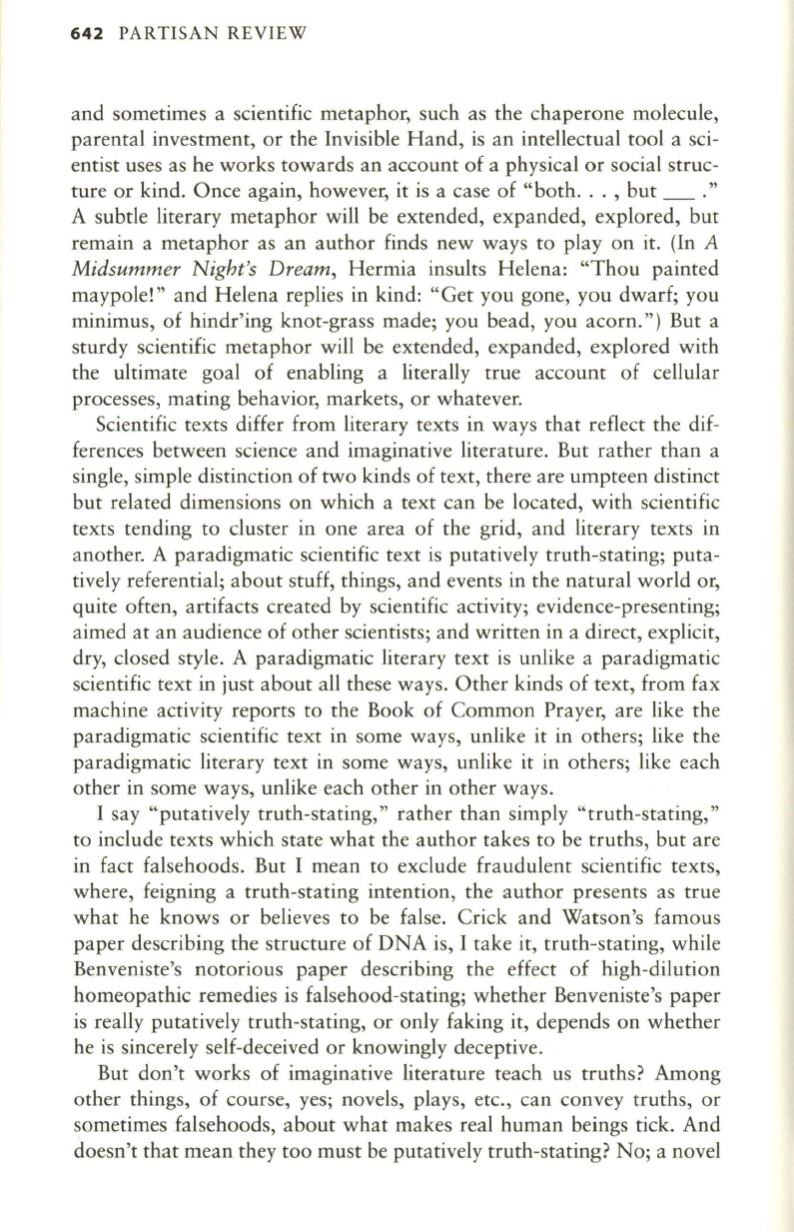
642
PARTISAN REVIEW
and sometimes a scientific metaphor, such as the chaperone molecule,
parental investment, or the Invisible Hand, is an intellectual tool a sci–
entist uses as he works towards an account of a physical or social struc–
ture or kind. Once again, however, it is a case of "both... , but _ ."
A subtle literary metaphor will be extended, expanded, explored, but
remain a metaphor as an author finds new ways to play on it. (In
A
Midsummer Night's Dream,
Hermia insults Helena: "Thou painted
maypole!" and Helena replies in kind: "Get you gone, you dwarf; you
minimus, of hindr'ing knot-grass made; you bead, you acorn.") But a
sturdy scientific metaphor will be extended, expanded, explored with
the ultimate goal of enabling a literally true account of cellular
processes, mating behavior, markets, or whatever.
Scientific texts differ from literary texts in ways that reflect the dif–
ferences between science and imaginative literature. But rather than a
single, simple distinction of two kinds of text, there are umpteen distinct
but related dimensions on which a text can be located, with scientific
texts tending to cluster in one area of the grid, and literary texts in
another. A paradigmatic scientific text is putatively truth-stating; puta–
tively referential; about stuff, things, and events in the natural world or,
quite often, artifacts created by scientific activity; evidence-presenting;
aimed at an audience of other scientists; and written in a direct, explicit,
dry, closed style. A paradigmatic literary text is unlike a paradigmatic
scientific text in just about all these ways. Other kinds of text, from fax
machine activity reports to the Book of Common Prayer, are like the
paradigmatic scientific text in some ways, unlike it in others; like the
paradigmatic literary text in some ways, unlike it in others; like each
other in some ways, unlike each other in other ways.
I say "putatively truth-stating," rather than simply "truth-stating,"
to include texts which state what the author takes to be truths, but are
in fact falsehoods. But I mean to exclude fraudulent scientific texts,
where, feigning a truth-stating intention, the author presents as true
what he knows or believes to be false. Crick and Watson's famous
paper describing the structure of DNA is, I take it, truth-stating, while
Benveniste's notorious paper describing the effect of high-dilution
homeopathic remedies is falsehood-stating; whether Benveniste's paper
is really putatively truth-stating, or only faking it, depends on whether
he is sincerely self-deceived or knowingly deceptive.
But don't works of imaginative literature teach us truths? Among
other things, of course, yes; novels, plays, etc., can convey truths, or
sometimes falsehoods, about what makes real human beings tick. And
doesn't that mean they too must be putatively truth-stating? No; a novel


